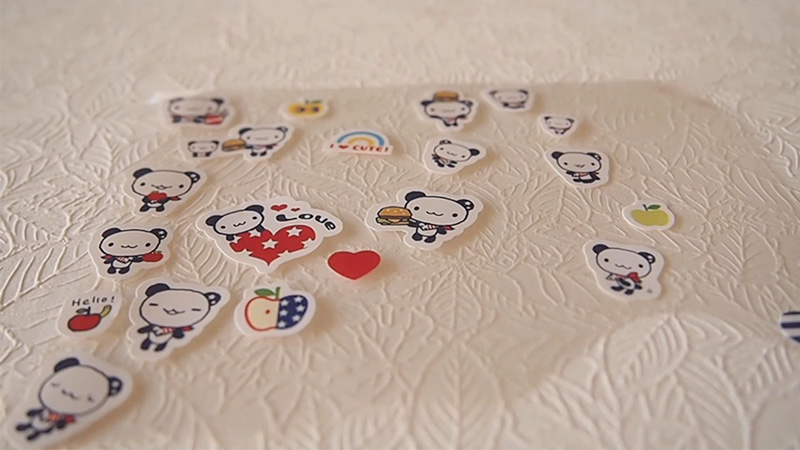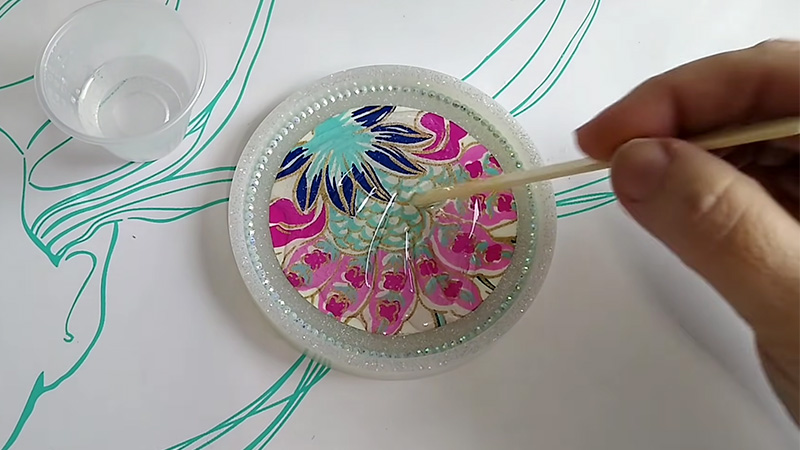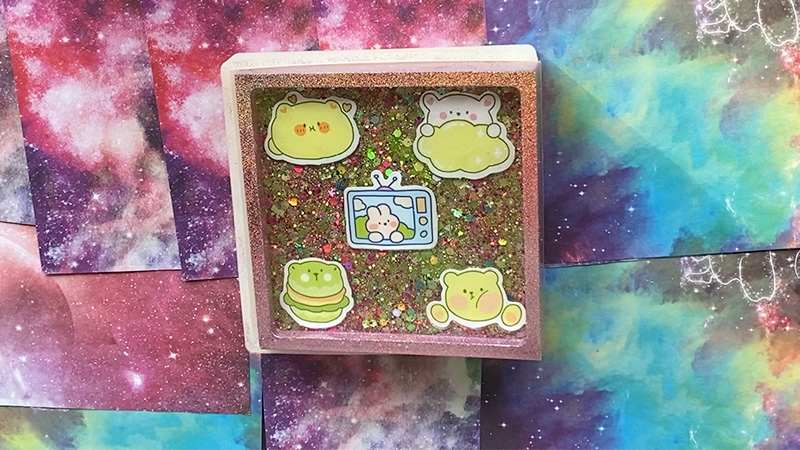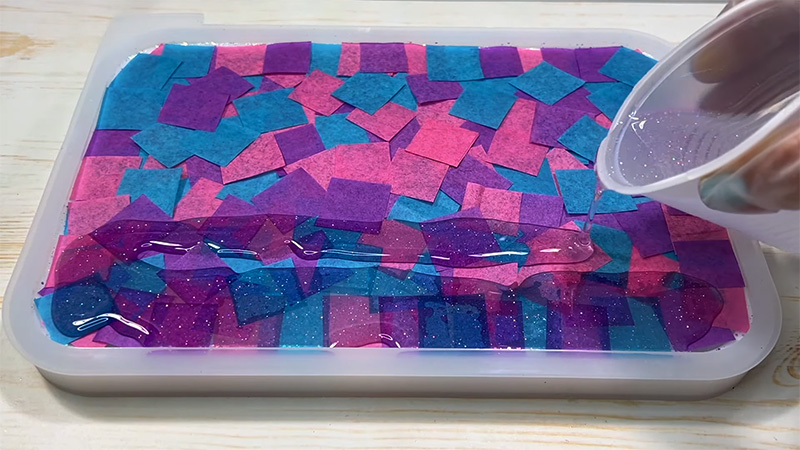Sealing paper for resin is a critical step in various crafting and art projects, holding great significance for a multitude of reasons. Whether you’re creating resin jewelry, artwork, or decorative items, understanding the importance of this process can lead to better results and ensure the longevity and quality of your creations.
This essential guide will walk you through the art of sealing paper for resin, offering two effective methods: using clear-drying glue and adhesive tape.
By following these techniques, you’ll protect your paper from moisture, enhance resin adhesion, prevent unsightly air bubbles, achieve clarity and transparency, and ultimately, create professional and enduring resin-based projects that showcase your creativity and skill.

How to Seal Paper for Resin? Two Ways
Sealing paper for resin is essential to protect it from moisture, enhance adhesion, prevent air bubbles, achieve clarity and transparency, ensure long-term durability, and create a professional appearance in your resin art and craft projects.
Here are two main methods to seal paper for resin:
Option 1: Using Clear-drying Glue

Sealing paper for resin with clear-drying glue is a popular choice. Learn how to protect your paper from moisture and create a suitable surface for resin application in this guide.
Gather Materials
To begin the process of sealing paper for resin, gather all the necessary materials. You’ll need clear-drying glue, such as Mod Podge or a similar craft adhesive, a paintbrush with soft bristles, and the paper you intend to seal.
Having these items ready beforehand will streamline the process and ensure a successful seal.
Prepare the Surface
Lay the paper you want to seal flat on a clean and dry surface. It’s crucial to work on a surface free from dust, debris, and any potential contaminants.
This ensures that the seal will be smooth and free of imperfections. Take care to ensure that the paper is laid flat without any wrinkles or creases, as these can affect the quality of the seal.
Apply the First Coat of Glue
Using the paintbrush, apply a thin, even layer of clear-drying glue to one side of the paper. Start at one corner and work your way across the paper’s surface, covering it entirely, including the edges.
Be mindful not to apply too much glue, as excessive glue can lead to wrinkling or warping of the paper. Strive for a smooth, uniform application.
Allow Drying
After applying the first coat of glue, exercise patience. Allow the glue to dry completely. The drying time can vary depending on environmental factors such as humidity and temperature, as well as the thickness of the glue.
This drying period may take several hours to a couple of days. Ensuring that the paper is entirely dry before moving on to the next step is essential, as it prevents moisture from affecting the paper when resin is applied.
Apply the Second Coat
Once the first coat is completely dry, it’s time to apply the second coat of clear-drying glue. Repeat the same method as in the previous step, using the paintbrush to achieve an even, thin layer of glue.
The second coat serves to enhance the paper’s protection and create a smooth surface for the resin to adhere to during your resin project.
Final Drying
Allow the second coat of glue to dry thoroughly before proceeding with your resin project. During this final drying period, any brush strokes or cloudiness from the glue will typically disappear, leaving you with a smooth and properly sealed paper surface.
Once both coats of glue are fully dry, your paper will be ready to be incorporated into your resin art project, ensuring a successful and long-lasting result.
Option 2: Using Adhesive Tape

Sealing paper for resin using adhesive tape is a straightforward method that provides protection and moisture resistance.
Here’s a concise guide on how to effectively seal paper for resin.
Gather Materials
To begin sealing paper for resin using adhesive tape, collect all the necessary materials. You’ll need clear adhesive tape and the paper you intend to seal.
Having these items ready beforehand will help streamline the process and ensure an effective seal.
Prepare the Surface
Lay the paper you want to seal flat on a clean and dry surface. It’s crucial to work on a surface that is free from dust, dirt, and other contaminants.
This ensures that the seal will be smooth and free of imperfections. Make sure the paper is positioned flat without any wrinkles or creases.
Apply the First Piece of Tape
Carefully apply a piece of clear adhesive tape to one side of the paper. Ensure that the tape covers the entire surface of the paper, leaving no exposed areas.
Take care to apply the tape smoothly, without wrinkles or air bubbles, to create a secure seal. Proper adhesion is essential for preventing moisture from penetrating the paper.
Apply the Second Piece of Tape
Flip the paper over and apply another piece of clear adhesive tape to the backside of the paper. This second piece of tape should slightly overlap the first piece, ensuring complete coverage.
As with the first piece of tape, ensure that it adheres well and is free from wrinkles or air bubbles.
Trim the Edges
Using scissors or a craft knife, carefully trim any excess tape from the edges of the paper. Be sure to leave a small margin of tape to ensure that the paper’s edges are fully sealed and protected.
Trimming the excess tape helps create a neat and tidy finish.
Final Check
Examine the sealed paper to ensure that there are no exposed edges or areas where moisture could potentially penetrate. Verify that both pieces of tape are securely adhered to the paper’s surface, providing a reliable barrier against moisture.
Why is It Important to Seal Paper for Resin?

Sealing paper for resin is a critical step in various crafting and art projects, and it holds great significance for a multitude of reasons. Understanding why it’s important to seal paper for resin can lead to better results and ensure the longevity and quality of your creations.
Moisture Protection
Paper is highly susceptible to moisture damage. It can warp, wrinkle, or become discolored when exposed to moisture. Resin, in particular, is highly sensitive to water.
Sealing the paper creates a protective barrier, preventing moisture from infiltrating the paper and causing damage.
Enhanced Adhesion
The resin adheres much more effectively to sealed surfaces than to untreated paper. A sealed paper surface provides a smoother, more stable foundation for the resin to bond with.
Proper adhesion ensures that the resin remains securely attached to the paper throughout the curing process, preventing delamination or detachment.
Air Bubble Prevention
When resin is applied to untreated paper, it has a tendency to trap air bubbles between the paper and the resin. These air bubbles can create unsightly imperfections in your finished project.
Sealing the paper reduces the likelihood of air bubbles forming, resulting in a smoother and more professional-looking final piece.
Clarity and Transparency
If your project requires transparency or a glass-like finish, sealing the paper is essential. Resin adheres evenly to a sealed surface, which enhances the clarity and transparency of the finished piece.
This is particularly important in resin art and jewelry making where clarity is a key aesthetic factor.
Long-term Durability
Sealing the paper enhances its durability. It protects the paper from potential damage, such as tearing or warping, ensuring the integrity of your artwork or crafts over time.
Sealed paper is less likely to degrade, making your creations more resistant to wear and tear.
Professional Appearance
Sealing the paper creates a more professional and polished appearance for your resin projects. It ensures that the paper remains flat and smooth, preventing any wrinkles or imperfections that might detract from the final result.
Whether you’re making jewelry, coasters, or art pieces, a sealed paper base sets the stage for a high-quality finished product.
10 Essential Tips for Sealing Paper for Resin Projects
Unlock the secrets to sealing paper for resin projects flawlessly with these 10 essential tips. Learn the techniques and materials that guarantee stunning, durable results in your creative endeavors.
Start With Quality Paper
Begin your resin project with high-quality paper or cardstock. Opt for thicker paper, as it’s less likely to warp or become translucent when resin is applied.
A strong foundation ensures a better end result.
Maintain a Clean Workspace
Keep your workspace clean and free of dust and debris. Even the tiniest particles can mar your resin project when they get trapped under the sealant or resin layers.
Practice on Scrap Paper
Before tackling your main project, practice the sealing process on scrap or test pieces of paper. This allows you to refine your technique, experiment with materials, and become comfortable with the process.
Choose Top-quality Sealants
Invest in high-quality clear-drying glue or clear adhesive tape. Premium materials provide a stronger seal and better protection for your paper, ensuring your artwork’s longevity.
Apply Sealant Evenly
Whether using glue or tape, apply it evenly to the paper’s surface. Smooth out any bubbles or wrinkles that may form during application using a tool or your fingertips for a flawless finish.
Thin Layers Work Best
When using glue, apply multiple thin layers rather than a single thick one. Thin layers dry more evenly and reduce the risk of warping or wrinkling.
Focus on Edges
Pay special attention to sealing the edges of the paper thoroughly. Edges are more vulnerable to moisture, so ensure they are well-covered to provide comprehensive protection.
Allow Proper Drying Time
Exercise patience and allow each layer of glue or tape to dry completely before adding more layers or proceeding with the resin application. This step is crucial to prevent moisture-related issues.
Maintain Clean Brushes and Tools
If you’re using a brush to apply glue, keep it clean and free from dried glue residue before each use. This ensures a smooth and even application. Additionally, maintain clean tools for pressing out bubbles or wrinkles.
Inspect and Prepare
Before applying resin, thoroughly inspect the sealed paper for imperfections or any exposed areas. Address any issues promptly to achieve a flawless result in your resin project.
FAQs
What type of paper is best for resin projects?
High-quality, thick paper or cardstock is best for resin projects to prevent warping, transparency issues, and ensure a sturdy foundation.
Can I use regular glue to seal paper for resin?
Yes, clear-drying craft glue, such as Mod Podge, is suitable for sealing paper for resin projects, providing protection and enhancing adhesion.
How many coats of glue should I apply?
Apply at least two thin coats of glue when sealing paper for resin. Allow each coat to dry completely before adding resin to ensure a solid seal.
Is adhesive tape a suitable alternative to glue for sealing paper?
Yes, clear adhesive tape can effectively seal paper for resin projects and is often quicker and easier to use.
Can I use sealed paper immediately with resin after it dries?
Yes, you can use sealed paper immediately with resin after it has dried. Once dry, the paper is ready to be incorporated into your resin project.
To Recap
Mastering the art of sealing paper for resin is a fundamental skill that can elevate your crafting and art projects to a new level of excellence.
By recognizing the significance of moisture protection, enhanced adhesion, air bubble prevention, clarity, durability, and professionalism, you ensure that your resin creations stand the test of time and maintain their visual appeal.
Whether you choose the method of using clear-drying glue or adhesive tape, the steps outlined in this guide offer you the means to safeguard your paper, preparing it for the transformative magic of resin.
These techniques empower you to unleash your creativity, confident in the knowledge that your sealed paper will serve as a strong foundation for stunning, long-lasting resin artworks and crafts that leave a lasting impression.
Leave a Reply